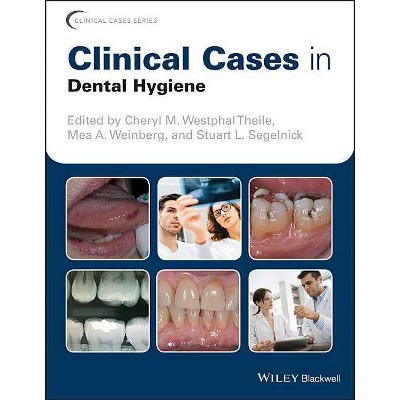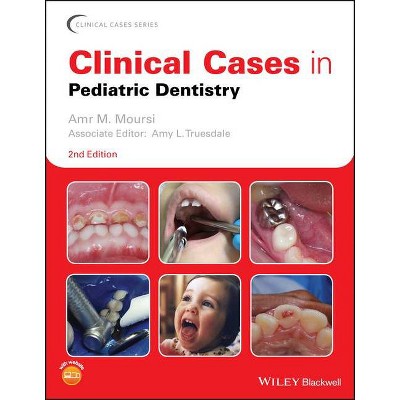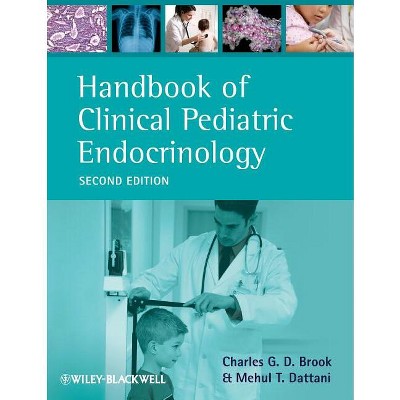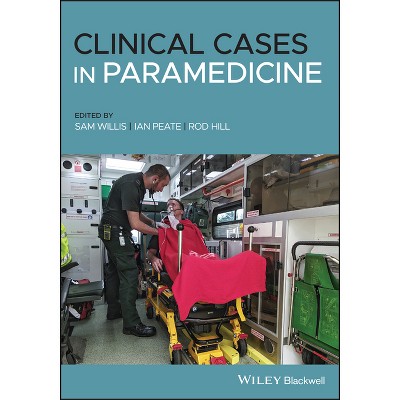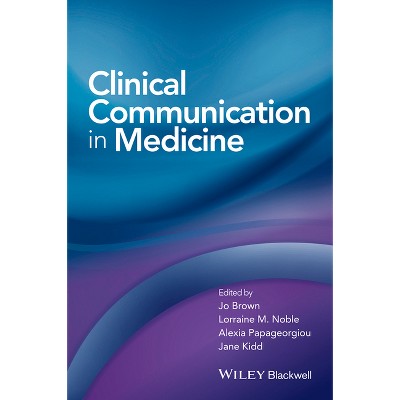Endodontic Advances and Evidence-Based Clinical Guidelines - by Hany M a Ahmed & Paul M H Dummer (Hardcover)

About this item
Highlights
- Explores recent research and innovations in the field of endodontics and provides evidence-based guidelines for contemporary dental practice Endodontic Advances and Evidence-Based Clinical Guidelines provides a comprehensive and up-to-date description of recent research findings and their impact on clinical practice.
- About the Author: Hany M. A. Ahmed, BDS, HDD, PhD, FICD, MDTFEd (RCSEd), FPFA, FADI, Senior Lecturer of Endodontics, Department of Restorative Dentistry, University of Malaya, Kuala Lumpur, Malaysia; Deputy Editor-in-Chief, European Endodontic Journal.
- 832 Pages
- Medical, Dentistry
Description
About the Book
"A thorough understanding of the biology of the dentine-pulp complex is essential to underpin new regenerative treatments and maximise clinical impact within endodontics. After microbial or traumatic insult, the dentine-pulp will mount a complex response, with a balance between infection control, inflammation and host defence responses critical to determining tissue outcomes. Assessment of the regenerative capacity of the damaged pulp can be challenging as biomarkers of interest may exhibit functionality in both inflammation and repair. This balance is evident during reactionary and reparative tertiary dentinogenesis, which is driven by the release of bioactive dentine-matrix-components (DMCs) from the damaged dentine. DMCs contain a range of cytokines, chemokines and growth factors, which are released following injury and orchestrate the recruitment, migration, proliferation and differentiation of pulpal progenitor cells critical for the formation of newly deposited dentine. The field of Regenerative Endodontics embraces the repair, replacement and regeneration of dentine-pulp tissue and needs to combine basic pulp biology research aimed at understanding molecular interactions in the tooth as well as clinical therapies, such as vital pulp treatment, revitalization and stem cell-based therapies. This chapter discusses current views of the molecular and cellular processes underlying both reparative and regenerative responses in the dentine-pulp complex"--Book Synopsis
Explores recent research and innovations in the field of endodontics and provides evidence-based guidelines for contemporary dental practice
Endodontic Advances and Evidence-Based Clinical Guidelines provides a comprehensive and up-to-date description of recent research findings and their impact on clinical practice. Using an innovative approach to the field, the book enables readers to translate the current body of knowledge on endodontic diseases and treatment into guidelines for enhancing patient care.
Divided into four parts, the book first addresses new research findings and advances in technology, techniques, materials, and clinical management. In addition, it provides revised clinical guidelines for a variety of areas within the specialty, such as endodontic diagnosis, treatment planning, management of endodontic emergencies, regenerative endodontic procedures, three-dimensional imaging, and the use of systemic antibiotics. Each chapter contains numerous high-quality illustrations and clinical cases highlighting current research directions, key concepts, and new trends in clinical techniques and education.
Endodontic Advances and Evidence-Based Clinical Guidelines:
- Presents the latest understanding of current literature, evidence, and clinical practice
- Examines new trends, treatments, and advanced diagnostic techniques in the field
- Covers a wide range of topics, including management of root canals, repair of perforation defects, removal of root filling materials, and alternatives to root canal treatment
Endodontic Advances and Evidence-Based Clinical Guidelines is an invaluable resource for undergraduate and postgraduate dental students, general dental practitioners, endodontic specialists, researchers in the field of endodontics, and clinicians, researchers, and educators in other fields of dentistry.
From the Back Cover
Explores recent research and innovations in the field of endodontics and provides evidence-based guidelines for contemporary dental practice
Endodontic Advances and Evidence-Based Clinical Guidelines provides a comprehensive and up-to-date description of recent research findings and their impact on clinical practice. Using an innovative approach to the field, the book enables readers to translate the current body of knowledge on endodontic diseases and treatment into guidelines for enhancing patient care.
Divided into four parts, the book first addresses new research findings and advances in technology, techniques, materials, and clinical management. In addition, it provides revised clinical guidelines for a variety of areas within the specialty, such as endodontic diagnosis, treatment planning, management of endodontic emergencies, regenerative endodontic procedures, three-dimensional imaging, and the use of systemic antibiotics. Each chapter contains numerous high-quality illustrations and clinical cases highlighting current research directions, key concepts, and new trends in clinical techniques and education.
Endodontic Advances and Evidence-Based Clinical Guidelines
- Presents the latest understanding of current literature, evidence, and clinical practice
- Examines new trends, treatments, and advanced diagnostic techniques in the field
- Covers a wide range of topics, including management of root canals, repair of perforation defects, removal of root filling materials, and alternatives to root canal treatment
Endodontic Advances and Evidence-Based Clinical Guidelines is an invaluable resource for undergraduate and postgraduate dental students, general dental practitioners, endodontic specialists, researchers in the field of endodontics, and clinicians, researchers, and educators in other fields of dentistry.
Review Quotes
"In summary, Endodontic Advances and Evidence-Based Clinical Guidelines is an extremely interesting, high-quality textbook that will bring great joy to any reader interested in endodontics. Due to its strengths and unique features, this book should be regarded as a "must-have" for any specialist in endodontics and for all practitioners with a main focus on and a keen interest in endodontics."
- Edgar Schäfer, ZMK-Klinik, Germany. Published in European Endodontic Journal (June 2023)
"The scope of this textbook is comprehensive and includes contemporary topics such as the introduction of the new coding system for root and canal morphology (Ahmed et al., 2017), updates in dental imaging, knowledge of the bioactive properties of dentine and molecular advances in pulp regeneration, use of calcium silicate cements, advances in equipment and techniques such as surgical endodontics and management of trauma. With a total of 30 chapters that contain high-quality figures and illustrations, this textbook covers most of the clinical considerations encountered in endodontic treatment"
"The academic rigour applied to the content in this textbook is commendable and I highly recommend this as one of the most useful resources I have seen for many years."
- Peter Cathro, Faculty of Dentistry, University of Otago, New Zealand. Published in Australian Endodontic Journal (April 23)
"The book covers a wide range of topics, including management of root canals, repair of perforation defects, removal of root filling materials, and alternatives to root canal treatment.
This format will enable undergraduate and postgraduate students, general dental practitioners, specialists, and clinical and non-clinical scientists to update their knowledge and engage with advanced treatment modalities that will have a significant, positive impact on patient management and treatment outcomes."
- Peter Folly, British Dental Association, Published in BDJ Student (Jan 23)
"The chapters are invariably well written and authoritative...the book's printing and binding are of good quality. Its photographs, radiographs, and tables and figures in general are produced in high-resolution. Numerous high-quality illustrations and clinical cases are evident highlighting key concepts, current research directions and trends in technologies. The very detailed and well-organised text layout gives the book merit as a reference for clinicians who wish to browse for a specific aspect of endodontic management.
The book is warmly recommended to dental libraries and to postgraduate students, general practitioners and endodontists with catholic interests in endodontics."
- Christine Y. Yu, BDSc, MDSc, PhD, UWA Dental School, The University of Western Australia, Published in Dental Traumatology
"Effectively illustrated throughout, "Endodontic Advances and Evidence-Based Clinical Guidelines" is impressively comprehensive, exceptionally well organized, and 'user friendly' in presentation -- making it a vitally important and unreservedly recommended addition to personal, professional, and academic library Dentistry & Endodontics collections and supplemental curriculum studies lists."
- Library Bookwatch, January 23, Midwest Book Review
About the Author
Hany M. A. Ahmed, BDS, HDD, PhD, FICD, MDTFEd (RCSEd), FPFA, FADI, Senior Lecturer of Endodontics, Department of Restorative Dentistry, University of Malaya, Kuala Lumpur, Malaysia; Deputy Editor-in-Chief, European Endodontic Journal.
Paul M. H. Dummer, BDS, MScD, PhD, DDSc, FDS (RCSEd), Emeritus Professor, School of Dentistry, Cardiff University, Cardiff, UK; Past President of the European Society of Endodontology; Former Editor-in-Chief, International Endodontic Journal.
Shipping details
Return details
Trending Diet, Health & Fitness Books







